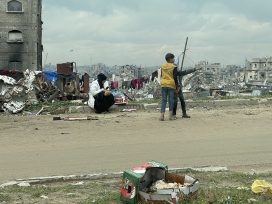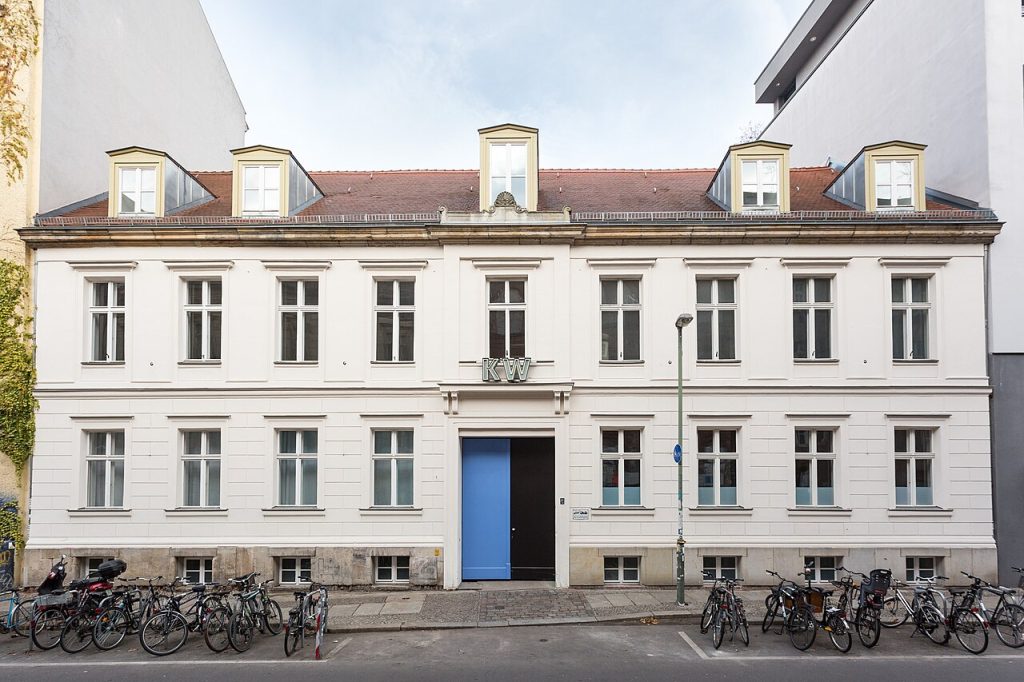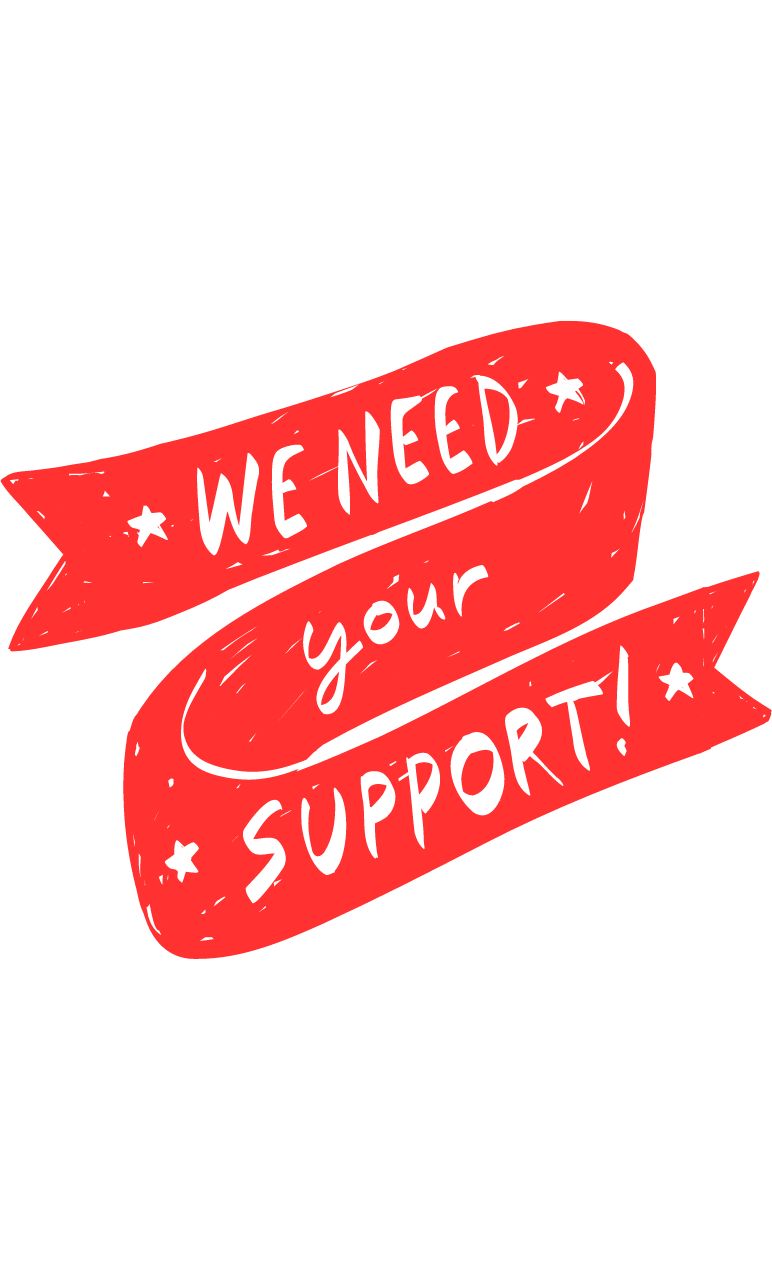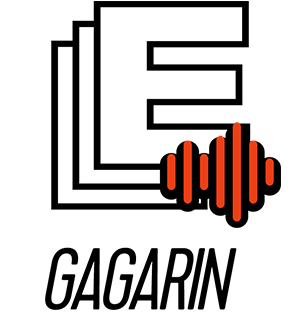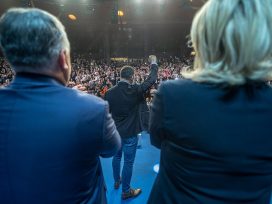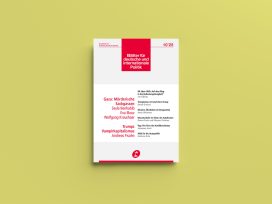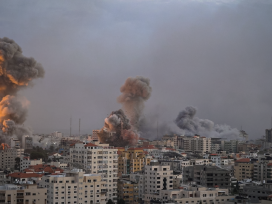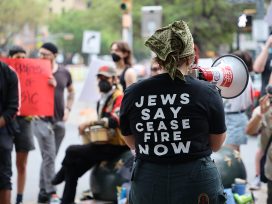The launch press conference for the 2025 Berlin Biennale, at the Sophiensäle in the city’s Mitte district, was filled to capacity. First to speak was Katarzyna Wielgow-Skolimowska, artistic director of Germany’s Federal Cultural Foundation, for many years a principal supporter of the biennale. This year’s exhibition, she told the audience, exuded its political credentials: “This biennale directs our gaze onto Berlin and the wider world simultaneously. The urgency of the present is showcased by many works formed under military violence and judicial arbitrariness.”
Zasha Colah, the Indian-born curator for the 13th Biennale, took a more circumspect tone. As a curator, Colah’s work has often focused on repressive contexts, and she has experience curating biennales: the Pune Biennale, and as co-curator of the Yinchuan Biennale in China in 2018.
This was a biennale on thinking even in the most constrained circumstances, she told the gathering. It was an anguished time, she continued, with media, the cultural landscape and politics in unrest.
A question from a journalist brought something of this anguish into the press conference. Were there any invited artists who declined to participate in the show, citing their affiliation with Strike Germany? One, Colah acknowledged. It was a decision that she respected, she added. Neither needed to say anything more about Strike Germany to the audience. Over the preceding two years, the alliance of artists, curators and other public figures had assumed symbolic prominence in the political turmoil roiling Germany’s cultural institutions.
A key element in Strike Germany’s formation was opposition to Germany’s unequivocal support of Israel in the wake of the ongoing Gaza war. The dependence of German cultural institutions on state funding, Strike Germany argued, renders them subservient to Germany’s Staatsräson. Meaning “reason of state”, this principle – articulated by Germany’s long-term chancellor Angela Merkel (CDU) in 2008 – places Israel’s security as central to Germany’s national interest. This perspective is grounded in the country’s historic responsibility for the Holocaust.
After October 2023 – when the Hamas attack on Israel sparked the ongoing, destructive military campaign in Gaza – Staatsräson began to be interpreted with greater breadth, and increasingly on cultural activity in Germany. By late 2023, hardly a week went by without multiple reports of cancelled exhibitions, award shows postponed indefinitely, or rescinded guest professorships. In prominent cases, Jewish-identifying artists like Candice Breitz and public intellectuals like Masha Gessen were accused of crossing a line with their criticism of the Gaza war.
This, however, is but an amplified aspect of a broader context – German cultural institutions are increasingly vigilant with respect to all matters concerning Israel and Palestine. Even before the Gaza war, this vigilance occasionally erupted into full-scale public controversies, as with the art exhibition documenta fifteen in 2022.
Held every five years in the German city of Kassel, the staging of the large-scale contemporary art show was curated by Indonesian collective ruangrupa. Their curatorial model was built on communal art-making, taking inspiration from Indonesia’s rural “lumbung” – communal storage barns for harvested rice. But the limits of the curatorial concept, intended to foreground marginalised perspectives from the Global South, became apparent after vociferous accusations of antisemitism were directed against specific exhibits. One prominently placed work, bearing obvious antisemitic tropes, was cordoned off with a curtain before being removed altogether. In the furore that ensued, the documenta’s general director, Sabine Schormann, was forced to resign. The consensus in the public discourse was that she should have been more proactive in avoiding or counteracting the crisis.
This fraught context weighed heavily on the 13th Berlin Biennale, which featured 60 artists and art collectives and 170 works, around half of these specially commissioned for the exhibition. It was the first to be staged since the beginning of the Gaza war. Breaking with the usual two-year cycle, the show opened in mid-June 2025, a year later than usual. Colah’s curatorial concept was “Passing the Fugitive On”, anchored by art’s subtle power to subvert through hide-and-seek and through humour.
In an interview with the German-language magazine Museumsjournal before the opening, Colah compared art biennales to games of chess, with the involvement of many different stakeholders. As prestige projects, biennales were constrained by political directives and had to navigate invisible red tape.
Many of the works on display were oriented around subversive acts in the face of oppression, past and present. Myanmar, once again under military rule following a 2021 coup, had a strong presence. “I wanted to show the country’s mature arts scene, it deserves more attention”, Colah told Index in the first of two extended conversations. Myanmar’s most prominent representative at the biennale was Htein Lin. Twice imprisoned in the past by military regimes, he was unable to leave the country, having been denied a passport.
On display at the KW Institute for Contemporary Art (KW) – traditionally the main site of the biennale – was a recording of the The Fly (2008), a performance that Htein first staged in prison for fellow detainees. At another venue, the former Courthouse, Lehrter Strasse, where art focuses on themes of legality and illegality, Htein’s prison paintings are presented across several rooms.
Back at KW, Lanna Action for Burma Committee, a feminist artist collective in exile, had a work one floor up from The Fly. Panties for Peace, as the name suggests, harnesses humour to undermine the iniquity of military rule. Drawing from a local superstition that contact with women’s underwear can weaken men, Lanna Action’s interventions have in the past included mailing women’s underwear to Burma’s embassies and putting up candidates with sobriquets like Madame Knickerbocker Glory for elections in the country.
Despite – or perhaps because of – the exhibition’s overt political tone and foregrounding of global injustice, the biennale drew criticism from those expecting … well, more on Palestine. Some reviewers were frustrated with the biennale’s “grating evasiveness” (Art in America); others found the exhibition “strangely muted in the context of a Berlin that has, over the past 16 months, been the centre of intense political turmoil” (Frieze).
And this poses an important question. Were the perceived shortcomings of the Berlin Biennale the result of oversight or omission – and if the latter, whose? Assuming that a clear curatorial positionality was out of the question within the institutional framework, even if this had been the intention of the show’s makers, it is still worth asking: Did the exhibition do anything in the way of gestures of solidarity? And if so, how did it go about this? Conversations with the biennale’s curator and director, as well as with several of the participating artists – and with one who was approached but ultimately did not take part – suggest that the exhibition wrestled with this on multiple levels. Nevertheless, the result falls short of what the curator, and even the institution of the biennale itself, had anticipated.
There were clear attempts in some of the exhibits, it should be said, to express some sense of solidarity with Palestine. And, as Index learnt from a conversation with the creator of a centrally exhibited multimedia work, the curators themselves took – at least at times – an invested approach to the Palestine question. Because the piece in question had been created under conditions of intense “anxiety and militarisation”, and to avoid putting elements of the project at risk, the artist only agreed to speak with Index on condition of full anonymity.
In early stages of planning the work, the artist and the curators – Zasha Colah and her co-curator Valentina Viviani – discussed the amount of artistic space that could be lent to expressions of solidarity with Palestine. Did the curators try to stop the artist from taking a clear stance on the issue, anxious about a potential public backlash? Quite the opposite: “They repeatedly asked [that the core of the exhibit be changed] to accommodate Palestine, and kept coming up with a bunch of ideas on how a gesture of solidarity could be included. Some of them were gimmicky …”. In other cases, the suggestions ran counter to the artist’s usual work practice. Did the artist feel this was an unusual move by curators? “Yes!” Nevertheless, the artist did appreciate the attempt at creative interjection: “The curator’s heart was in the right place.” The artist observed that after all, their work was driven by parallel relations to Palestine. Eventually, they agreed on a gesture of solidarity to be incorporated into the work.
But when the time came to draw up contracts and discuss the specifics of the installation, more people joined the conversation. And not everyone, it seemed, wanted to sing from the same hymn sheet. The artist recalled a Zoom meeting in February this year: “When I mentioned Palestine … a member of the administrative team became visibly tense. It was as if they’d been unaware of all the discussions we’d been having for months. I could see Zasha and Valentina feel [sic] uncomfortable about this.” Despite the tension, the administrative team and the artists agreed on the specifics of the work’s implementation, including multiple pro-Palestinian gestures.
But then it was the artist who didn’t follow through. When Colah unpacked what the artist had sent over, the new version had been markedly toned down and now carried a different symbolism altogether. Over to the artist: why the change of heart? “For me, this choice was about resisting the way such symbols often get pulled into the marketing of war and spectacle”, the artist observed.
Was the biennale attempting to counter fears of a backlash like those faced by the documenta organisers in trying to ring-fence, in a manner of speaking, space for Palestinian perspectives and Palestinian solidarity? At one point, at least one Palestinian artist was expected to participate in the biennale. Ultimately, the artist declined the invitation. Colah facilitated contact between this artist, from Jerusalem, and Index.
The artist was “never fully in”, Index learnt. After being approached by Colah in the summer of 2024, they participated in a series of conversations, having confidence in the curator’s clear position on the Palestine issue. In the artist’s perception, the biennale seemed keen to move on to the logistics of setting up the work. In December 2024, the artist had a meeting with the biennale’s director and curators. It was at this point that it became clear, to the artist, that participation was impossible. “There was no clear statement, direction or any structural positionality, which is the least I expect amidst ongoing genocide”, the artist told Index.
If artists invited to participate in the biennale had been able to forge alliances with each other, things may have evolved somewhat differently; they would have been able to reinforce their political stance, knowing that they would not stand alone should controversy ensue. But they had no information about the identity of other invited artists. The biennale had decided to keep the full participation list embargoed, only releasing it to the public on the day of the press conference.
This, Index was told by biennale staff, was intended to prevent the artists’ participation from being politicised before the opening. It reflects another lesson from documenta fifteen. In the months leading up to the Kassel exhibition, documenta had grappled with multiple accusations concerning participants supporting the Boycott, Diversify and Sanctions (BDS) campaign targeting Israel. In 2019, the German Bundestag passed a non-binding resolution declaring the BDS movement antisemitic.
Well-meaning as the decision not to disclose the artist list may seem, it did have the effect of isolating the artists; they had to make the decision about participating alone. This may explain, at least in part, why none of the multiple withdrawals became public. In addition to the Palestinian artist who spoke with Index, several other artists – most with ties to the Middle East – either withdrew or turned down the invitation. “Three of the project proposals were in very final stages, including research visits to Berlin,” Colah told Index. According to the curators, the artists feared that participation would have repercussions for their future careers.
The Palestinian artist from Jerusalem who had been approached suspected that the biennale had wanted to include a mild Palestinian voice. The artist doubted, however, that it would be the work itself that the audience would be focusing on. “In the current German context, it’s not like the artwork would ever be assessed on its merit, however poetic it may be.” During their final meeting, Axel Wieder, the biennale’s director, seemed intent on persuading the artist to join, the artist felt. But on asking how the biennale could protect them, what the artist was told was not satisfactory.
Behind the scenes, it seemed that staff were trying to tease out whether some of the exhibition’s other participants were willing to stand with the Palestinian artist in the event of a public backlash. Separately, the anonymous artist responsible for the multimedia work commented that, over the course of a year, the approach regarding Palestinian solidarity changed. “First, they asked if we could stand with the Palestinian artists. However, we had no clue who they were, and later we didn’t know who dropped out and why. The conversation eventually shifted to asking us to incorporate symbols of Palestine into our work.”
Beyond keeping the participation list secret and informally sounding out potential alliances between peers, what is a biennale’s role in protecting its artists, given the present German context – and what realistic steps can it take by way of support? “We were clear on the fact that we weren’t going to take any works out of the show. We had full trust in the curator and the artists”, Axel Wieder, director of the Berlin Biennale told Index. And: “We focus on aspects that are within our area of control.” Index learnt that the biennale does have a crisis handbook, but was unable to glean much about its concrete operation in practice.
Wieder took over as director of the Berlin Biennale a year ago, following Gabriele Horn’s two-decade tenure. When he joined, plans for the 13th edition were well underway. In a lengthy video call with Index, Wieder discussed his acclimatisation into his new role. In the context of the Berlin Biennale: “The level of attention is certainly different”, Wieder said diplomatically. “The political situation is heated.” Before Berlin, Wieder had spent ten years in Sweden and Norway, his last post being the directorship of Bergen Kunsthall.
What responsibility should an institution like the Berlin Biennale have for preparing international curators, given the realistic expectation of a backlash? Wieder confirmed that he and Colah held regular “exchanges on cultural politics”, sometimes twice a week. What did they talk about? “It was about getting a sense for what certain works might be perceived like, what responses they might generate if presented in one way or another”, Wieder replied. At other times, they had detailed conversations about the implementation and positioning of individual works. Intended to shield the biennale as much as possible from attacks, it would seem that they succeeded in protecting the curator and its artists from accusations of antisemitism, or of crossing the boundaries of Staatsräson.
For all the gestures of solidarity with Palestine, planned or attempted, that ultimately didn’t make it into the show, was there anything on Palestine on display at the biennale – no matter how fugitive this may be, as per its overarching theme? Some critics have discerned subversive gestures throughout. According to the art journal e-flux: “As the visitor walks through the show, a series of oblique, often brilliantly conceived references to Palestine accumulate. Collectively, they conspire to make the powerful claim that the reason we are looking for something that doesn’t appear is because we already know what’s going on.”
Simon Wachsmuth’s video work, From Heaven High (2025), shown at the former Courthouse, Lehrter Strasse, was cited as a case in point. Over 30 minutes, it presents the absurd cross-examination, by a judge, of a pig-masked figure in Prussian military uniform. When asked where it comes from, the masked figure replies: “From the river, over the mountain, to the sea.” Wachsmuth conceived the piece as a tribute to Prussian Archangel, a 1920 antimilitaristic Dada work, and the artists who were tried for defaming the army.
Similar references can be read into several other works. Armin Linke’s Negotiation Tables (2025) was prominently on display at the entrance to the KW. In the work, Linke revisits the 1878 Congress of Berlin, during which the special international status of Jerusalem was formally acknowledged, a political decision which continues to reverberate to the present day. On the top floor, large banners presented details of the global arms trade, including deals with Israel. The declarative banners were part of Gesamtkunstwerk as a Practical Joke (2025), a site-specific installation by Sawangwongse Yawnghwe, another artist from Myanmar.
For the biennale’s curators and administrators, “fugitive” gestures of solidarity, however frustratingly futile, were preferable to nothing. But in the face of Israel’s breathtaking devastation of Gaza, destruction escalating to new levels week after week, any gesture from the Berlin Biennale would feel all but inconsequential.
The Palestinian artist who had been approached to exhibit at the biennale told Index that they didn’t know what hosting a biennale in Germany meant right now. It would feel hurtful to participate, they said, as the country had been directly backing the onslaught on Gaza, through military exports to Israel and its fervent and wide-reaching commitment to Israel’s security: “By participating, I would be part of that structure.”
Whatever the ambitions or intentions of its curators and administrators, it appears that they were dealing with a number of boundaries shaping what the biennale could say or display. The institutional framework of the biennale as a state-funded event, for one thing, precluded any structural positionality – especially given the presence of Staatsräson as an overriding principle. Then, there were the lessons from the documenta and the heated public debate. There were any number of reasons for artists to choose not to participate: fear of a polarised public outcry, concerns that the institutional structures offered insufficient protection against a political backlash, allegiance with Strike Germany. Self-censorship could have also factored into decisions not to participate or influenced how certain artworks did or did not include gestures of pro-Palestinian solidarity.
But even within these constraints, curators and several artists did succeed in smuggling in gestures of solidarity. Wilfully crossing the boundaries, as the last documenta was perceived by many to have done, would have likely escalated into yet another serious confrontation between vested interests, potentially sparking a stronger drive towards the political oversight of contemporary art. As things stand, the damage-control measures of the Berlin Biennale, even though designed to avoid a documenta-style debacle, ended up leaving artists, curators and academics, inside and outside Germany, feeling alienated. The pervading sense was that what is currently permissible in Germany’s cultural sector simply isn’t enough.
The anonymous artist behind the multimedia exhibit told me that their work had developed out of contexts defined by scrutiny and surveillance in their home country. In Germany, those same pressures applied: “Berlin, the art capital of the world is no different in this respect. The curator’s concept tragically succeeds in exposing the condition of scrutiny of the biennale. The show was left to depend on what we as artists creatively express or don’t. Coming under such pressure is a risk probably not all artists could take.”
The 13th Berlin Biennale closed on 14 September 2025.
